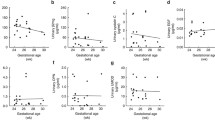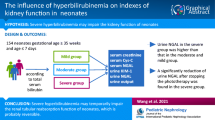Abstract
Background
The incidence of acute kidney injury (AKI) among the neonates treated at the Neonatal Intensive Care Unit is high with high mortality rates. Glutathione S-transferase (GST) class Pi plays an important role in the protection of cells from cytotoxic and oncogenic agents. The aim of the study was to examine whether the levels of serum glutathione S-transferase Pi (GST Pi) determined after birth have any predictive value for the outcome and development of AKI in premature neonates.
Methods
The prospective study included 36 premature neonates. The data about morbidity was gathered for all the neonates included in the study. The blood samples were taken in the first 6 h of life and GST Pi levels were measured.
Results
The mean values and standard deviations of GST Pi among the neonates who died and who survived were 1.904 ± 0.4535 vs 1.434 ± 0.444 ng/ml (p = 0.0128). Logistic regression revealed a statistically significant, positive correlation between GST Pi levels and death (p = 0.0180, OR7.5954; CI 1.4148–40.7748).The mean value of GST Pi levels in the neonates with AKI was higher than in neonates without AKI (p = 0.011).
Conclusions
The conclusion of our study is that high levels of serum GST Pi in the first 6 h after birth are associated with an increased mortality and development of AKI in prematurely born neonates.

Similar content being viewed by others
Abbreviations
- AKI:
-
Acute kidney injury
- GST:
-
Glutathione S-transferase
- pO2 :
-
Partial pressure of oxygen
- NICU:
-
Neonatal Intensive Care Units
- SCr:
-
Serum creatinine
- AKIN:
-
Acute Kidney Injury Network
- UOP:
-
Urine output
- GA:
-
Gestational age
- BW:
-
Birth weight
- FiO2 :
-
Fraction of inspired oxygen
- ICH:
-
Intracranial hemorrhage
- EOS:
-
Early-onset sepsis
- GFR:
-
Glomerular filtration rate (GFR)
- NGAL:
-
Neutrophil gelatinase-associated lipocalin
- KIM-1:
-
Kidney injury molecule-1
- IL-18:
-
Interleukin 18
- DNA:
-
Deoxyribonucleic acid
References
Perrone S, Negro S, Tataranno ML, Buonocore G (2010) Oxidative stress and antioxidant strategies in newborns. J Matern Fetal Neonatal Med 23(Suppl 3):63–65
Negia R, Pandea D, Karkia K, Kumarb A, Khannac RS, Khanna HD (2014) A novel approach to study oxidative stress in neonatal respiratory distress syndrome. BBA Clin 3:65–69
Buonocore G, Perrone S (2006) Biomarkers of oxidative stress in the fetus and newborn. Hematol Rep 2(10):103–107
Andreoli SP (2004) Acute renal failure in the newborn. Semin Perinatol 28:112–123
Askenazi DJ, Ambalavanan N, Goldstein LS (2009) Acute kidney injury in critically ill newborns: what do we know? What do we need to learn? Pediatr Nephrol 24(2):265–274
Jetton JG, Askenazi JD (2012) Update on acute kidney injury in the neonate. Curr Opin Pediatr 24(2):191–196
Lunn AJF, Shaheen I, Watson AR (2006) Acute renal insufficiency in the neonatal intensive care unit. Arch Dis Child Fetal Neonatal Ed 91(5):F388
Cataldi L, Leone R, Moretti U, De Mitri B, Fanos V, Ruggeri L, Sabatino G, Torcasio F, Zanardo V, Attardo G, Riccobene F, Martano C, Benini D, Cuzzolin L (2005) Potential risk factors for the development of acute renal failure in preterm newborn infants: a case-control study. Arch Dis Child Fetal Neonatol Ed 90:F514–F519
Kungwani AR, Nimbalkar AS, Sethi AR, Patel DV, Nimbalkar SM (2012) 1324 clinical profile and outcome of newborns with acute kidney injury in a level 3 neonatal unit in western India. Arch Dis Child 97:A377
Koralkar R, Ambalavanan N, Levitan EB, McGwin G, Goldstein S, Askenazi D (2011) Acute kidney injury reduces survival in very low birth weight infants. Pediatr Res 69(4):354–358
Stojanović V, Barišić N, Radovanović T, Bjelica M, Milanović B, Doronjski A (2017) Acute kidney injury in premature newborns-definition, etiology, and outcome. Pediatr Nephrol 32(10):1963–1970
Sheehan D, Meade G, Foley VM, Dowd CA (2001) Structure, function and evolution of glutathione transferase: implications for classification of non-mammalian members of an ancient enzyme superfamily. Biochem J 360:1–16
Harrison DJ, Kharbanda R, Scott Cunningham D, McLellan LI, Hayes JD (1989) Distribution of glutathione S-transferase isoenzymes in human kidney: basis for possible markers of renal injury. J Clin Pathol 42:624–628
Townsend DM, Manevich Y, He L, Hutchens S, Pazoles CJ, Tew KD (2009) Novel role for glutathione S- transferase π regulator of protein S-glutathionylation following oxidative and nitrosative stress. J Biol Chem 284(1):436–445
Maulik D, Zanelli S, Numagami Y, Ohnishi ST, Mishra OP, Delivoria-Papadopoulos M (1999) Oxygen free radical generation during in-utero hypoxia in the fetal guinie pig brain: the effects of maturity and of magnesium sulfate administration. Brain Res 817:117–122
Frank L, Sosenko IR (1991) Failure of premature rabbits to increase antioxidant enzymes during hyperoxic exposure: increased susceptibility to pulmonary oxygen toxicity compared with term rabbits. Pediatr Res 29:292
Speer CP, Silverman M (1998) Issues relating to children born prematurely. Eur Respir J Suppl 27:13s–16s
Ciccoli L, Rossi V, Leoncini S, Signorini C, Paffetti P, Bracci R, Buonocore G, Comporti M (2003) Iron release in erythrocytes and plasma non protein-bound iron in hypoxic and non hypoxic newborns. Free Radic Res 37:51–58
Mannervik B (1987) The isoenzymes of glutathione S-transferase. Adv Enzymol Relat Areas Mol Biol 57:357–417
Hayes JD, Strange RC (2000) Glutathione S-transferase polymorphisms and their biological consequences. Pharmacology 61:154–166
Walshe CM, Odejayi F, Ng S, Marsh B (2009) Urinary glutathione S-transferase as an early marker for renal dysfunction in patients admitted to intensive care with sepsis. Crit Care Resusc 11(3):204–209
McMahon BA, Koyner JL, Murray PT (2010) Urinary glutathione S-transferases in the pathogenesis and diagnostic evaluation of acute kidney injury following cardiac surgery: a critical review. Curr Opin Crit Care 16(6):550–555
Sundberg A, Appelkvist EL, Dallner G, Nilsson R (1994) Gluthatione transferases in the urine: sensitive methods for detection of kidney damage induced by nephrotoxic agents in humans. Environ Health Perspect 102:293–296
Shu KH, Wang CH, Wu CH, Huang TM, Wu PC, Lai CH, Tseng LJ, Conolly R, Wu VC (2016) Urinary π-glutathione S-transferase predicts advanced acute kidney injury following cardiovascular surgery. Sci Rep 6:26335
Auron A, Mihanna MJ (2006) Serum creatinine in very low birth weight infants during their first days of life. J Perinatol 26(12):755–760
Askenazi DJ, Koralkar R, Hundley HE (2012) Urine biomarkers predict acute kidney injury in newborns. J Pediatr 161(2):270–275
Askenazi DJ, Montesanti A, Hunley A (2011) Urine biomarkers predict acute kidney injury and mortality in very low birth weight infants. J Pediatr 159(6):907–912
Gerosa C, Iacovidou N, Argyri I, Fanni D, Papalois A, Aroni F, Faa G, Xanthos T, Fanos V (2015) Histopathology of renal asphyxia in newborn piglets: individual susceptibility to tubular changes. World J Nephrol 4(2):313–318
Sharawy N (2013) Prediction of acute kidney injury during sepsis: unsolved mystery yet. OA. Crit Care 1(2):14
Sarvary E, Blazovics A, Varga M, Sulyok B, Jaray J, Lakatos M, Perner F (1998) Diagnostic value of glutathione-S-transferase. Orv Hetil 139(25):1531–1537
Serwin NM, Wiśniewska M, Jesionowska A, Skwirczyńska E, Marcinowska Z, Dołęgowska B (2016) Serum levels of 12 renal function and injury markers in patients with glomerulonephritis. Pol Arch Med Wewn 126(7-8):483–493
Author information
Authors and Affiliations
Corresponding author
Ethics declarations
Ethical approval
All procedures performed in the studies involving human participants were in accordance with the ethical standards of the institutional and/or national research committee and with the 1964 Helsinki Declaration and its later amendments or comparable ethical standards.
Conflict of interest
The authors declare that they have no conflict of interest.
Informed consent
Informed consent was obtained from all the individual participants included in the study.
Rights and permissions
About this article
Cite this article
Stojanović, V.D., Barišić, N.A., Radovanović, T.D. et al. Serum glutathione S-transferase Pi as predictor of the outcome and acute kidney injury in premature newborns. Pediatr Nephrol 33, 1251–1256 (2018). https://doi.org/10.1007/s00467-018-3910-x
Received:
Revised:
Accepted:
Published:
Issue Date:
DOI: https://doi.org/10.1007/s00467-018-3910-x




